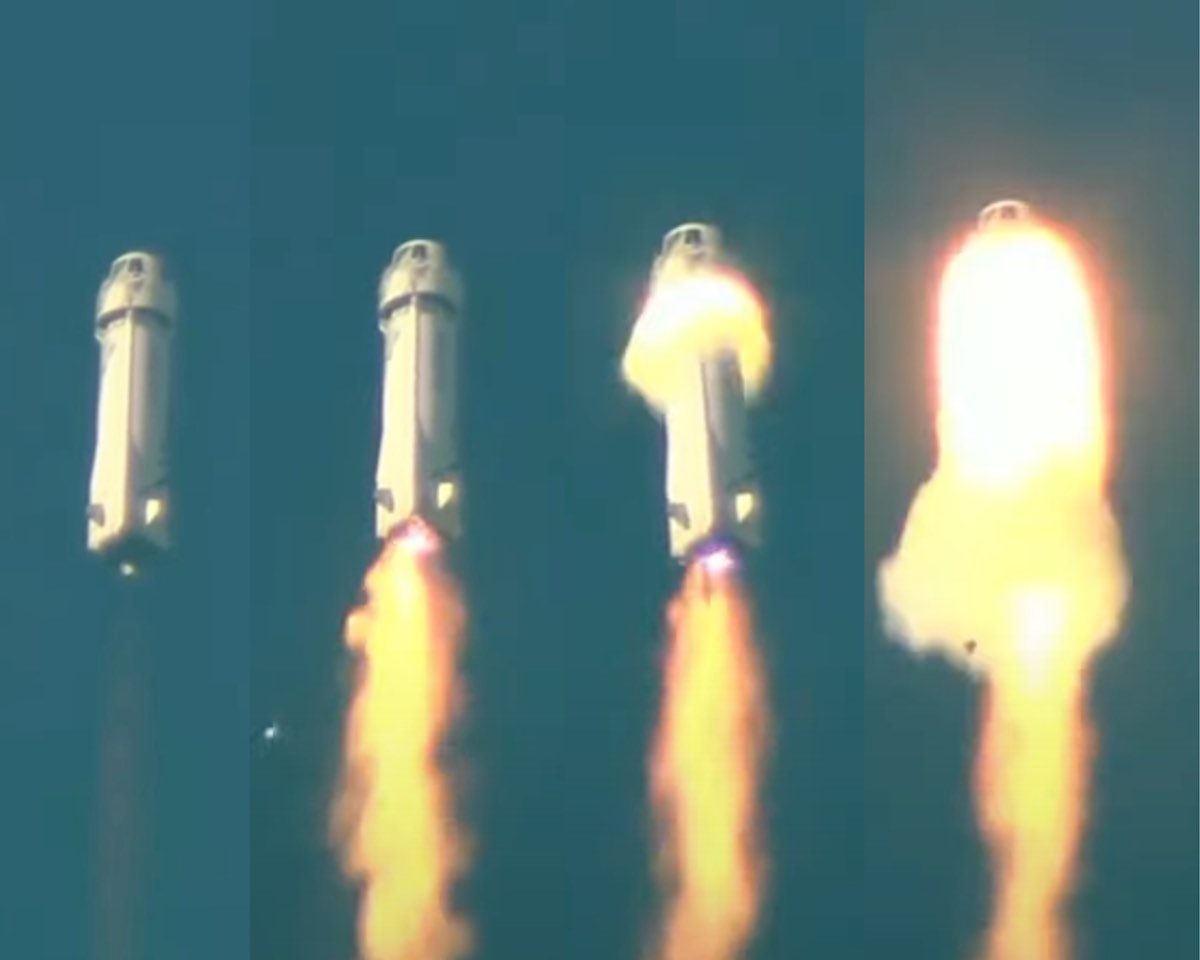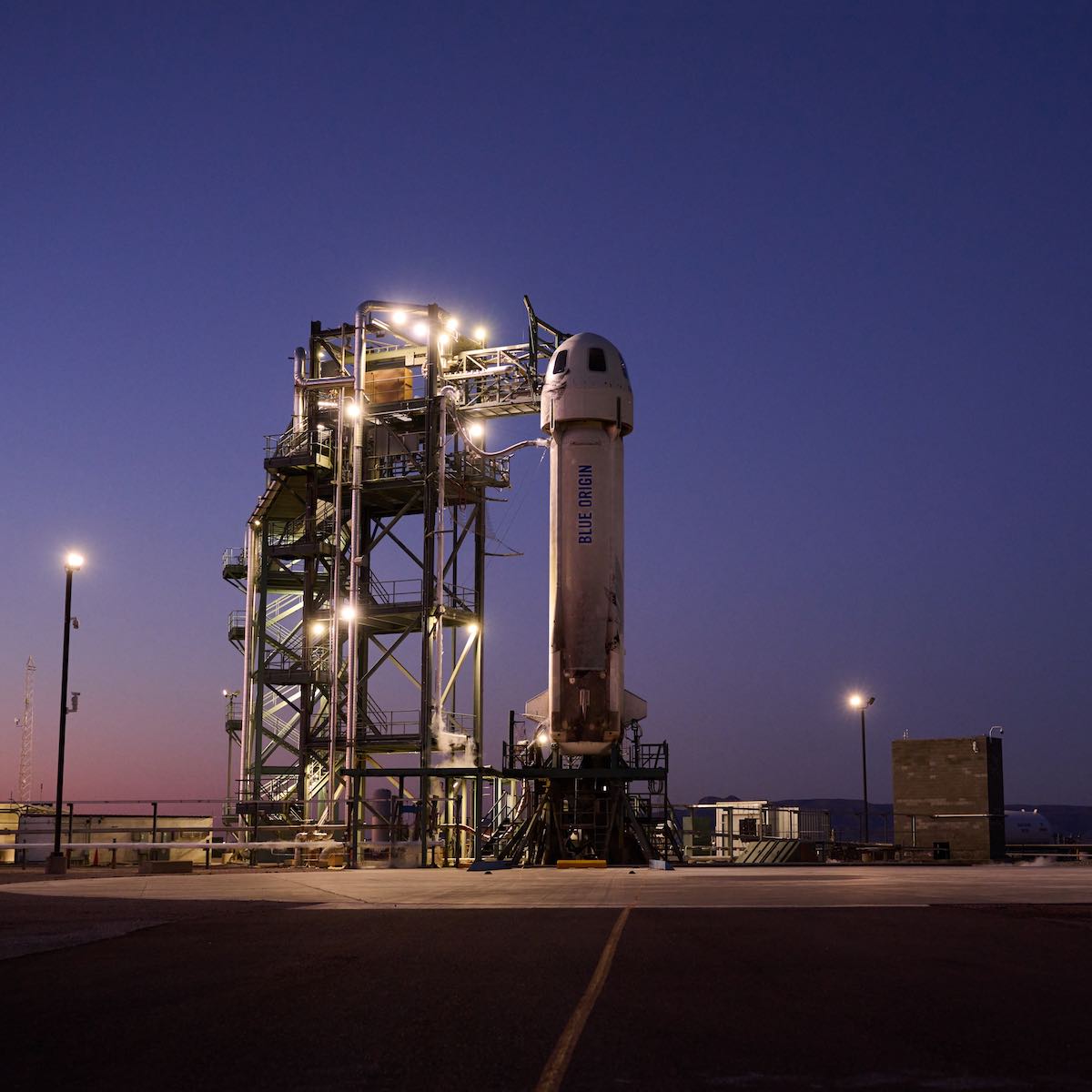
The suborbital rocket developed by Jeff Bezos’s space company Blue Origin suffered its first launch failure Monday, when the main engine on the New Shepard booster appeared to cut out about a minute after liftoff from West Texas. The crew capsule, which carried NASA-funded experiments but no people, safely landed under parachutes after firing an abort motor to escape the stricken booster.
The unplanned in-flight abort saved the company’s reusable capsule, and the mission’s experiment payloads stowed inside. But one of Blue Origin’s two operational suborbital New Shepard boosters, which hosted its own research payloads, was lost in the launch failure.
Blue Origin’s live webcast showed the rocket lifting off from the company’s sprawling 80,000-acre launch facility north of Van Horn, Texas, around 10:26 a.m. EDT (9:26 a.m. CDT; 1426 GMT), after a nearly hour-long delay.
A single hydrogen-fueled BE-3 engine powered the 60-foot-tall (18-meter) booster off the launch pad. About a minute after liftoff, as the rocket neared supersonic speed, the plume from the BE-3 engine appeared to change color and shape, then the powerplant appeared to shut down, causing the rocket to tilt off its planned trajectory at an altitude of around 28,000 feet (8,500 meters).
The solid-fueled abort motor on bottom of the crew capsule fired immediately, delivering an instant pulse of 70,000 pounds of thrust to push the craft away from the failing rocket.
The four-ton capsule spun around and tumbled after the abort motor’s brief firing, which propelled the vehicle hundreds of feet away from the New Shepard rocket. Guided by reaction control system thrusters, the capsule’s motion stabilized as it deployed three drogue parachutes and three main chutes for a relatively gentle ride back to the ground. The capsule was designed to touch down at a speed of around 3 mph (5 kilometers per hour).
Launch abort! Blue Origin’s New Shepard capsule has fired its abort motor after a failure of its booster. https://t.co/zFP9nJ7ONR pic.twitter.com/pzqMZ7UVPl
— Spaceflight Now (@SpaceflightNow) September 12, 2022
“It appears we have experienced an anomaly on today’s flight,” said Erika Wagner, Blue Origin’s payload sales director and host of the company’s launch webcast Monday. “This was unplanned and we don’t have any details yet, but our crew capsule was able to escape successfully.”
The craft fired soft-landing thrusters and touched down on the desert floor in West Texas about five-and-a-half minutes after liftoff.
“You can see how our backup safety systems kicked in today to keep our payloads safe during an off-nominal situation,” Wagner said after the capsule landed. “Safety is our highest value at Blue Origin. It’s why we built so much redundancy into the system.”
Blue Origin tweeted later that the capsule escape system functioned as designed. The company completed an in-flight demonstration of the capsule escape system in 2016, proving the abort motor could safely propel the spacecraft and passengers away from a rocket failure. During the 2016 test, the New Shepard booster survived the abort maneuver and returned to the ground for a vertical touchdown on a nearby landing pad.
Blue Origin said the booster impacted the ground after the launch failure Monday. The behavior of the engine may suggest a propulsion system failure, leaving no chance for recovering the rocket intact.
The Federal Aviation Administration, the agency charged with ensuring public safety during commercial spaceflight operations, said it will oversee Blue Origin’s internal investigation of the launch failure.
“The anomaly that occurred triggered the capsule escape system,” the FAA said in a statement. “The capsule landed safely and the booster impacted within the designated hazard area. No injuries or public property damage have been reported.
“This was a payload only mission; there were no humans aboard,” the FAA said. “ Before the New Shepard vehicle can return to flight, the FAA will determine whether any system, process, or procedure related to the mishap affected public safety. This is standard practice for all mishap investigations.”
The mission Monday, numbered NS-23, marked the 23rd flight of a New Shepard rocket, and the ninth launch of this reusable booster, paired with the crew capsule “RSS H.G. Wells,” which also made its ninth flight. It was the first time a New Shepard rocket has failed on launch. The first test flight of the New Shepard booster suffered a failure on landing in 2015, and Blue Origin lost the vehicle.
Blue Origin’s crew capsule has landed back in Texas after an unplanned in-flight abort. The capsule is flying NASA-sponsored experiments on today’s flight, but no people.
The spacecraft fired its solid-fueled abort motor about a minute after liftoff.https://t.co/zFP9nJ7ONR pic.twitter.com/4dtqJrEoGb
— Spaceflight Now (@SpaceflightNow) September 12, 2022
The NS-23 mission was initially set to launch Aug. 31, but poor weather forced the company to call off launch attempts on three consecutive days. Officials then rescheduled the launch date for Monday, Sept. 12.
Blue Origin has launched six flights to suborbital space with human passengers since July 2021, when company founder Jeff Bezos joined three others on a suborbital launch. Most recently, the company sent six passengers to suborbital space Aug. 4, using a different booster and capsule in Blue Origin’s fleet. In total, Blue Origin has flown 31 people to space to date.
Chris Boshuizen, a space industry entrepreneur who purchased a seat on a New Shepard rocket last year, said the presence of the crew capsule’s launch escape system gave him the confidence to take the trip to space with Blue Origin.
“For my flight on NS-18 last October, it was ultimately the knowledge that I was sitting on top of (a) giant solid rocket motor gave me the reassurance I needed,” Boshuizen tweeted. “Thankfully we didn’t need to use it, but I was glad it was there.
“As you saw today, the escape motor lights up hard and pulls 11+ Gs so it won’t be a fun ride, but you’ll survive,” Boshuizen tweeted.
“It’s not the outcome anyone would want, they will likely find the cause and eliminate it, and that’s one less thing to go wrong on future launches.”
The booster and capsule flown Monday were dedicated to flying science and research payloads to space, according to Blue Origin. The company’s crew-configured rocket and capsule are undergoing refurbishment for a future flight.
Blue Origin has built and flown four New Shepard vehicles so far, including the rocket destroyed on landing in 2015, another vehicle now retired, the rocket lost Monday, and the human-rated rocket devoted to human spaceflight missions.
The NS-23 mission carried 36 payloads from research institutions and student organizations, half of which are funded by NASA. The rocket was supposed to soar into the rarefied uppermost layers of the atmosphere, targeting an altitude just above 60 miles (100 kilometers), the internationally recognized boundary of space.
The BE-3 main engine was expected to fire for about 2 minutes and 20 seconds, then switch off before the crew capsule separated from the New Shepard booster. The capsule and booster were supposed to coast to apogee, the highest point of the flight, before falling back to Earth for landing.
Liftoff of Blue Origin’s New Shepard booster from West Texas, heading for suborbital space with 36 science, tech demo, and education payloads for NASA, universities, and research institutions. https://t.co/zFP9nJ7ONR pic.twitter.com/WkmafJ2myv
— Spaceflight Now (@SpaceflightNow) September 12, 2022
The 36 payloads flying on the NS-23 mission included hydrogen fuel cell technology developed by Infinity Fuel Cell and Hydrogen Inc., a company based in Windsor, Connecticut, with a NASA-funded contract to develop an Advanced Modular Power and Energy System. The AMPES fuel cell technology could be used to generate power for future lunar rovers and surface habitats, and Blue Origin’s launch was expected to allow engineers to test some of the hardware in microgravity.
Another NASA-funded experiment on the New Shepard flight Monday came from Honeybee Robotics, a subsidiary of Blue Origin, and was designed to study the strength of planetary soils under different gravity conditions.
An investigation from the University of Florida was to test a fluorescence imaging system that enables biological research on suborbital missions, and researchers from MIT Media Lab flew an experiment called “Wax Casting” to test how future explorers could produce their own non-toxic solid rocket propellants in microgravity, such as paraffin and beeswax. The Wax Casting experiment was supposed to study how melted candle wax and a similar liquid called heptadecane react when they are rotated in tubes aboard the New Shepard capsule.
The Electrostatic Regolith Interaction Experiment from the University of Central Florida, also supported by NASA, was to study the behavior of charged dust particles in microgravity. Information from this experiment could help engineers develop strategies to prevent lunar dust from damaging electronics, solar cells, mechanical equipment, and astronaut spacesuits on the moon, according to UCF.
There was also an experiment on the NS-23 mission from NeoCity Academy in Kissimmee, Florida, where six high school students developed an investigation to study the effects of microgravity on ultrasonic sound waves. Another project from Anatolia College in Greece was attempting to create a painting in space.

Two sensor suites flying on the New Shepard rocket were designed to measure data on the environment outside the vehicle. A fiber optic sensor system developed by NASA’s Armstrong Flight Research Center was to monitor the structural health of the vehicle, collecting temperature and strain data on the NS-23 mission before future use on orbital launch vehicles.
A space sensor platform from Johns Hopkins University’s Applied Physics Laboratory was also mounted on the New Shepard booster. It was designed to study environmental conditions in the lower ionosphere, a difficult-to-study region of Earth’s atmosphere. Scientists hope to expand the platform’s capabilities on future flights to include telescopes, cameras, and deployment of small sensors, according to Blue Origin.
Email the author.
Follow Stephen Clark on Twitter: @StephenClark1.
